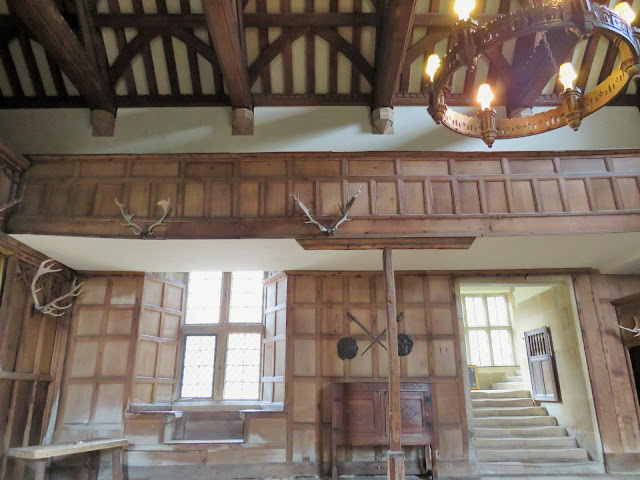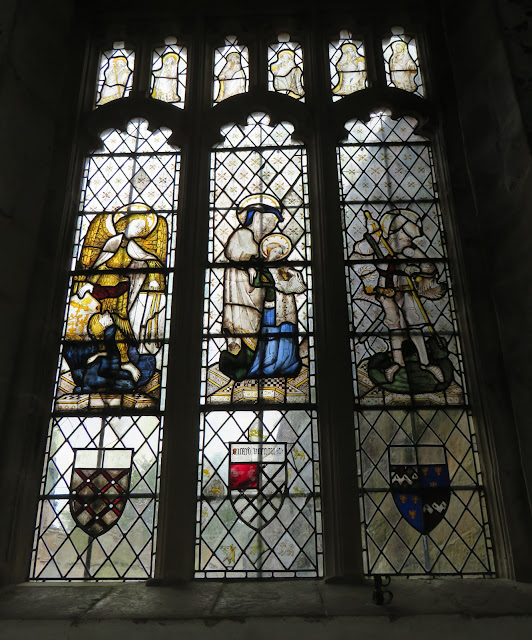Haddon Hall
Haddon Hall is a medieval manor house near Bakewell in Derbyshire, described as the most complete surviving house of the Tudor period. It is currently occupied by Lord Edward Manners (brother of the Duke of Rutland) and his family - and has been in this same family since 1563.
The car park is on the opposite side on the main road (A6), and after crossing this, you are at the Gate house to the property. This is an impressive building in itself; now home to a delightful little shop selling souvenirs, books, toys and plants. After obtaining a ticket at the wooden hut, you can continue, over the river towards the house.
Before reaching the main house, you will see the quaint stable-block cottage cottage with fabulous topiary in the shape of a boar's head and peacock, in the garden (representing the Vernon and Manners families); and the old stable block next door is now a restaurant and toilet block.
The path to reach the entrance to the house is rather steep - not really disabled friendly; but when this place was built, it was for its position and defence - not accessibility. You do have to take great care throughout the entire property, as the courtyard, floors, stairs and flagstones are all uneven.
The first glimpses you have, are of the courtyard and you immediately get the feeling of Haddon being a castle - although it was never one; but it was given a licence to build a protective wall in 1194. The manor was mentioned in the Doomsday Book and since that time it has been the home of the influential Vernon then Manners families. From the courtyard you can go into the main hall and chambers upstairs, or the chapel, museum and exhibition rooms on the opposite side.
Through the main door, which is surrounded by wonderful scented roses in the summer; and you are immediately in the banqueting hall which dates from 1370. What a marvellous room this is! Every day at 1/4 to the hour, visitors are given a welcome talk in this room which is well worth attending - to learn more about the hall and its residents.
This hall includes small sections from the 11th century, but mostly it is from the 13th century when the Vernon family added several additional rooms. Look up at the ceiling and the minstrels gallery and imagine how evenings were spent in here.
Having an open fire, with the smell and the warmth, really takes you back to another time. In the 14th century the fire would have been in the centre of the room, but that was later been replaced with a hearth and chimney - to take the smoke out of the room.
The hall was not lived in from 1703 until the 1920's (as the family had moved to Belvoir Castle), so the hall remained unchanged for 200 years - untouched in times when most places like this were undergoing major renovations. Whereas most properties would have been altered, upgraded or extended, Haddon was left almost unaltered - which is why it is so unique today.
The large Millefleurs Tapestry shows the coat of arms of King Edward 4th and was made during his reign 1461 - 1483; it was presented to the Vernon family by King Henry 8th, for the loyalty they had shown to the royal family .
In the 1920's John Manners (9th Duke of Rutland) realised how important Haddon hall was and he spent the rest of his life trying to restore it to its medieval glory. He had many photographs taken showing the preservation and restoration work he had done, and the meticulous work he actually carried out himself.

From here you can go up the well trodden stone staircase to the upper rooms.
John and Dorothy Manners inherited the hall in 1565 and set about restyling it in the Elizabethan fashion of that time; adding this 110 foot long room (The Long Gallery) with a high ceiling, alcoved bay windows and intricate woodwork and plaster work.


As well as marvellous leaded windows, this exquisite room has a large fireplace, paintings and carvings bearing the emblems of the family.

Occasionally there are special events happening in the Long Gallery and when I went, there was a young lady playing a lyre. But when it was first made, as well as being a room to entertain guests - it would have been used as somewhere to exercise indoors.


Back downstairs and across the courtyard, and you will find St Nicholas Chapel which was completed in 1427 but has Saxon foundations. It is not like any other Chapel I have ever seen. You can listen to another informative talk in here, which is so interesting - don't miss it!

The high sided oak box-pews, on either side of the Chapel date back to the 16th century and were for the family and their guests to sit in. Whereas the 5 oak pews at the back of the Chapel would have been for the servants.

This part was the original Chapel, which was later extended; and the circular lead-lined font here was from Norman times.
This marble effigy is of Robert Manners, Lord Haddon (8th Duke of Rutland), who should have inherited the hall - but he died when he was only 9 year old. In her grief, his mother spent many years creating a lifelike effigy of her beloved son; the original is in the chapel at Belvoir Castle.
This alabaster panels below the stained glass windows, shows the life of Christ - and there is another one in the museum of The Last Supper. The original stained glass was stolen to order when the family wasn't in residence - that is why the replacement glass doesn't show any faces.
The frescoes on the walls were painstakingly uncovered by John Manners - and each of the drawings have a particular religious meaning. These were originally commissioned by Richard Vernon 7th in the 15th century but were plastered and white washed over during the reformation (ironically though, this did help to preserve them). They were originally coloured but only the outlines have survived.

Over the centuries, Haddon's owners collected quite a number of exquisite tapestries; that would have been really expensive in their time and a statement of the families wealth. Whilst the hall was being restored in 1925, the tapestries were taken down and stored in the stable block building; but a fire broke out and unfortunately most of these were lost. In the courtyard there is a room explaining what happened to the tapestries and show what has been done with the pieces that have been salvaged.
If you look closely you will see how some of the salvaged pieces have been sewn onto large pieces of cloth - the effect from a distance is like looking through a Georgian window!
Also from the courtyard, you can see King John's Wall that dates back to 1195.
Back to the main house and you can visit the marvellous Tudor kitchen and areas associated with food preparation and storage. There is even a room where you can watch a show on the television of people trying to live as they would have in medieval times - made right here at Haddon.
Imagine kneading and rolling foodstuff so much, that it made marks like this in the wooden bench. So they just carried on and moved further along the bench.
There are a few more rooms with rich tapestries and panelled walls - all different to each other.
The small museum is a fascinating room - most of the items in here were collected by John Manners (9th Duke of Rutland) during his restoration of Haddon.
There are floor plans showing where each piece of treasure was found, underneath the floor, in between the walls, inside panelling - even in the working and servants areas.
The Alabaster panel of The Last Supper.
Outside into the garden, where you will see more restoration. The original Elizabethan walled garden which had become overgrown with ivy and weeds has been tenderly renewed and replanted.
The knot garden, on one of the terraces, with colourful planting and clipped yew trees, really enhance the view of the Hall; making you see what an impressive building it really is.
In days gone by, there would have been a bowling green on this terrace.
Down to the lower terrace and if it is right time of the year, you will see Haddon's magnificent collection of roses - with so many different wonderful aromas.

The views over the distant countryside remind you how peaceful and isolated Haddon is - with rolling green hills and the River Wye gently running through its grounds.
Haddon Hall has featured in numerous films such as several Jane Eyre ones, Elizabeth, Pride and Prejudice, The Other Boleyn Girl and the 2018 Mary Queen of Scots; and in various television documentaries and dramas - the latest one being Gunpowder in 2017.
I thoroughly enjoyed my visit to Haddon Hall and can highly recommend it, especially for anyone who loves stories of medieval history, wants to know more about Derbyshire or has a passion for restored properties. Haddon Hall in open every day from April until October; for more information -
Lynne
Please check out my other blogs:-














































Excellent tour of an amazing place - I could spend hours here (and I'm guessing you did!). Imagine living in it. The chapel must have been stunning before the Reformation.
ReplyDeleteThank you. Great tour!
ReplyDelete